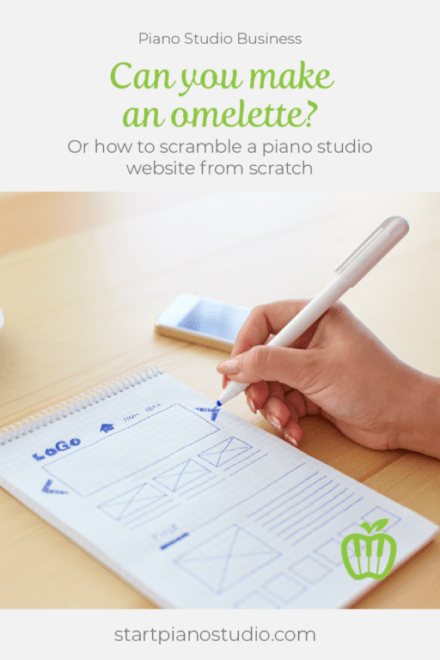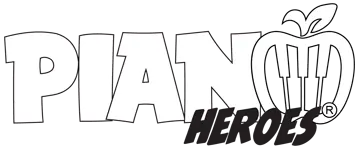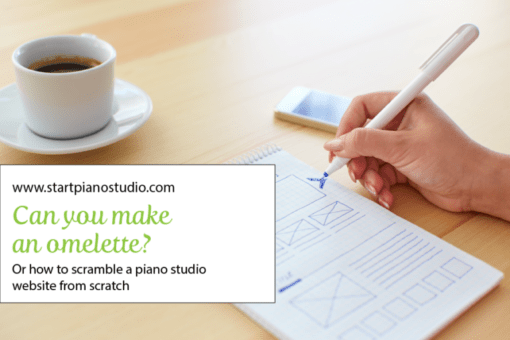Hello and welcome to our series of blog posts on how to start a piano studio! Remember how you registered your piano studio’s very own domain name and then created its branded email address? How did that feel? When it comes to the Internet it all starts with claiming your domain name on the Internet and once you have done so the rest is naturally coming along. There are enough reasons to believe that in these days of age Internet presence is vital for any successful piano studio and in this blog post we are talking about the first step in the creation of your piano studio website, the planning phase.
In our previous posts, we helped you with the piano studio’s basic building blocks such as its name, domain, and email address. We highly recommend you catch up if you are missing any of those. In the next couple of blog posts our focus is on your piano studio website, however, without a name, domain and piano studio email address working on the website is a bit premature so please please please make sure you have those before you read any further!
How many ways to cook the eggs?
I know at least four ways to cook the eggs and depending on the mood and the ingredients my preference for the method changes. Same with the Internet today. There are so many different ways of creating a website that it solely depends on your time, budget and sometimes who you are married to (lol). All in all, it depends. Our goal though is to show you some of the ways you could do it by yourself and don’t feel intimidated by the sheer complexity. We do believe that cooking the eggs just like creating the website for your piano studio is simple, but let’s start with the basics.

Web basics
You may not have thought about it this way, but by creating a website for your piano studio you are in fact contributing to the World Wide Web! Surprised? You are helping people to collaborate and exchange information faster. The web is a huge collection of linked documents or pages, and your piano studio website is going to have several of them. Read more about the Web on Wikipedia. Have you ever wondered what the Web is built of?
Resources and URIs
The resource is a way of calling the page, image or any other document of your piano studio website and the URI is the unique address of that resource on the Internet. Pages of your piano studio website are the resources. There are no two resources with the same URI on the Internet. Whenever you create a new resource its URI (or often called the URL too) is born and from this point on the URI must always point to the resource otherwise, the World Wide Web gets broken. What if you want to rename one of the URIs? Please subscribe and stay tuned, we will talk about this in one of our future posts. And for now, let’s touch on the glue of the Web.
Links
If resources are what the Web is built of, then the links are what is holding the Web together. The links are bringing prospective customers to your website. Links are pointing to the actual resources. Just like https://differentpiano.studio/contact may point to the valid contact us page where customers will find more details on how they can contact your piano studio; the page like https://learnpiano.studio/policy may reference the piano studio policy which you can text to your prospective clients. Links help your customers to get the information they need quickly. What are we using the links for?
Pages for your piano studio website
The most common questions you will hear from the customers are going to be about your piano studio fees, policies and your method. One way to deal with those questions is to answer them one by one every time which will cost you a lot of time and effort. We recommend creating a generic page for each answer instead. Each page will have a unique name and its purpose. And later you will link them over and over again in your emails, text messages, and ads.
The links may look like /policy, /fees, /contact-us, /about-us, /method, /philosophy, etc. Make the URLs for those pages simple and pronounceable so you can just type them in your text message or say it on the phone. Main pages will create the foundation for your piano studio presence on the Internet and will provide the single source of truth for conflict resolutions or misunderstandings.
Take your time and list the pages and their URIs in a text editor of your choice. Think through the purpose of each page and draft the high-level content you put out there as a list of bullet points. At this stage there are no mandatory or absolutely required pages when it comes to the website, it is all your choice and preference!
Piano studio information architecture example:
- Home https://abc-piano.studio/
- the home landing page of the ABC piano studio
- CTAs pointing to the other pages with the short descriptions
- the major dates for the seasons and holidays
- the pictures of the credentials or the licenses
- Philosophy https://abc-piano.studio/philosophy
- the teaching method and the philosophy
- Policy https://abc-piano.studio/policy
- registration terms and conditions
- piano books policy
- money back policy
- payment policy
- Fees https://abc-piano.studio/fees
- breakdown of the fees
- Contact https://abc-piano.studio/contact
- contact details e.g. address, phone, email, etc.
We trust you have completed this simple exercise. Believe it or not, you have just created a plan for your piano studio website. Your next step should be to write just enough content for each page. And once that is done you will be ready to deploy it. In our next post, we are talking about that. Don’t forget to subscribe to our monthly giveaway and stay tuned.
Start piano studio and enjoy teaching the piano!

